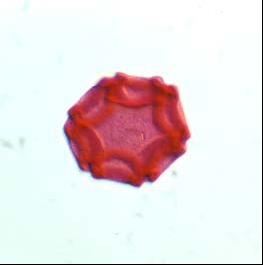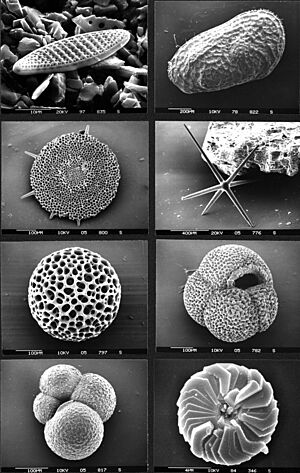Micropaleontology facts for kids
Micropaleontology is a special part of paleontology. It focuses on studying very tiny fossils called microfossils. These fossils are usually smaller than four millimeters, and often even less than one millimeter. Because they are so small, scientists need a microscope to see and study them closely.
Microfossils come from almost every type of organism that has ever lived. They can tell us a lot about what the environment was like in the past. For example, they show us what the climate was like or what kinds of plants and animals lived in an area long ago.
People who study these tiny fossils are called micropaleontologists. They use skills like Taxonomy (classifying living things) and statistics (using numbers and data) to understand what they find.
Where Do We Find Microfossils?
Microfossils are most often found in sediment that settled under water. This includes places like oceans and lakes. Over long periods, these sediments can turn into rock. Scientists use special methods to get microfossils out of these rocks.
For example, some tiny creatures like diatoms have shells made of silica. Scientists can use acid to dissolve the rock around these shells, leaving the delicate silica fossils behind. This helps them study the fossils without damaging them.
Types of Microfossils
Micropaleontology is divided into different areas based on what the microfossils are made of. Each type needs different ways to be studied and separated from the rock.
- Silica: Some microfossils, like the shells of diatoms, are made of Silicon dioxide.
- Chalk: Many microfossils, such as the shells of coccoliths and foraminifera, are made of chalk (calcium carbonate).
- Phosphate: Tiny pieces of bones or teeth from vertebrates (animals with backbones) are made of phosphate.
- Organic compounds: This group includes things like ancient pollen and spores.
The study of fossil pollen and spores is a special field called palynology. It helps scientists learn about ancient plants and climates.

Images for kids
-
Diatomaceous earth is a soft rock made of tiny diatom shells. This image shows different shapes of diatoms in water.
-
Fossil nummulitid foraminiferans from the Eocene period, found in the United Arab Emirates. The scale shows sizes in millimeters.
See also
 In Spanish: Micropaleontología para niños
In Spanish: Micropaleontología para niños




